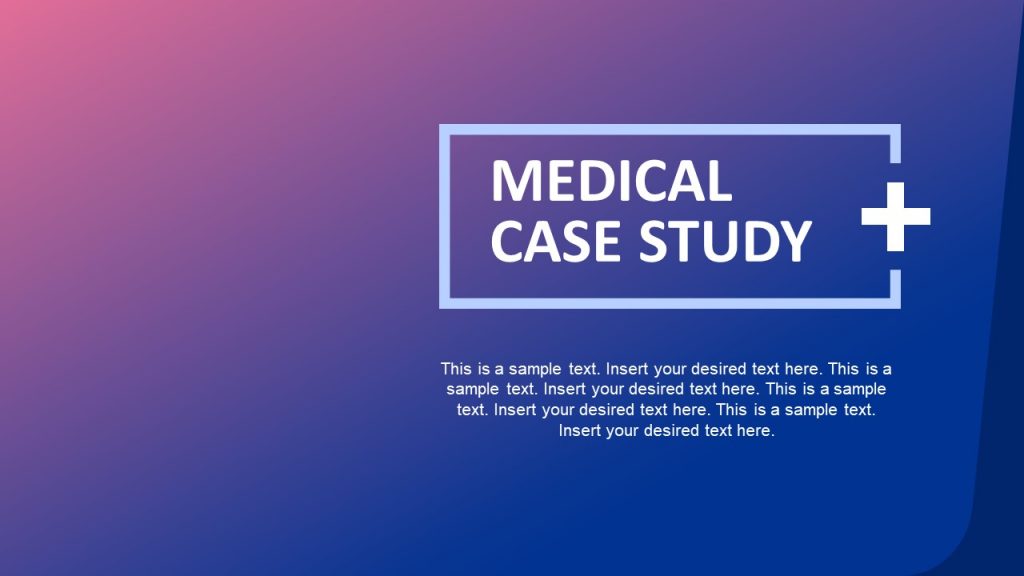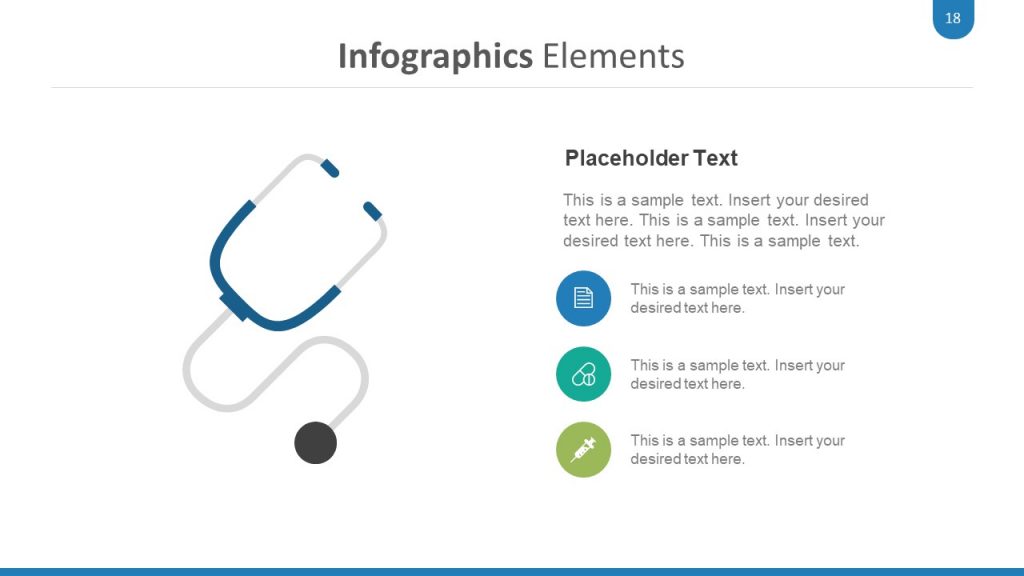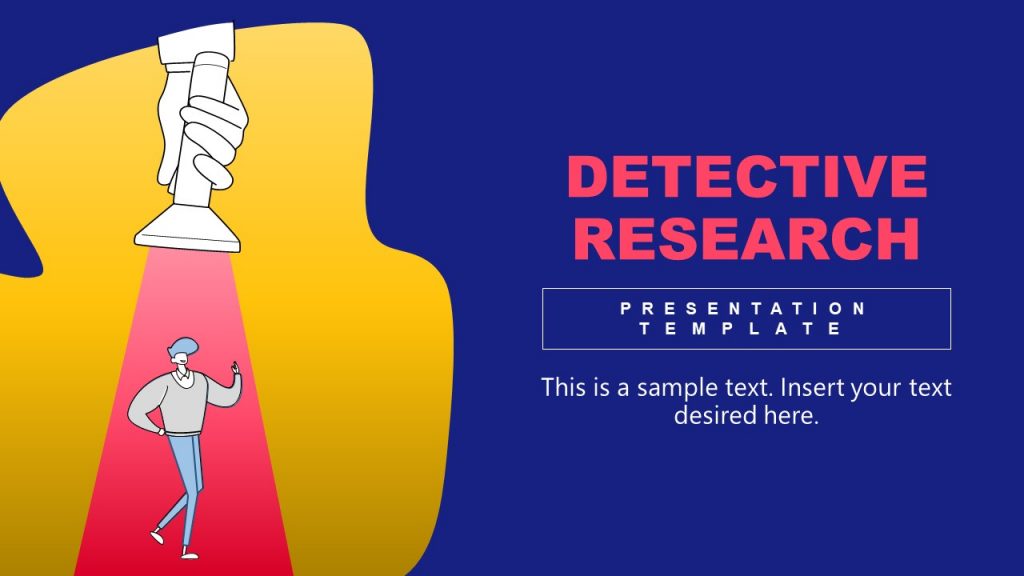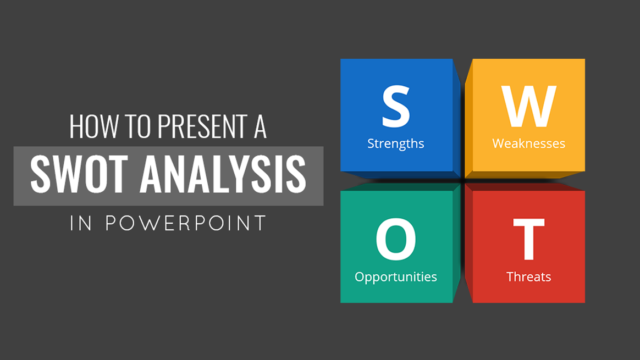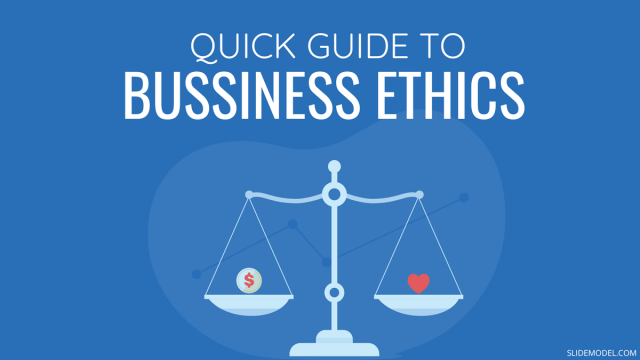
Marketers, consultants, salespeople, and all other types of business managers often use case study analysis to highlight a success story, showing how an exciting problem can be or was addressed. But how do you create a compelling case study and then turn it into a memorable presentation? Get a lowdown from this post!
Table of Contents
- What is a Case Study?
- Popular Case Study Format Types
- How to Write a Case Study: a 4-Step Framework
- How to Do a Case Study Presentation: 3 Proven Tips
- Case Study Presentation Structure: One-Slide vs. Multi-Slide
- How Long Should a Case Study Be?
- Final Tip: Use Compelling Presentation Visuals
- Business Case Study Examples
What is a Case Study?
Let’s start with this great case study definition by the University of South Caroline:
In the social sciences, the term case study refers to both a method of analysis and a specific research design for examining a problem, both of which can generalize findings across populations.
In simpler terms, a case study is investigative research into a problem aimed at presenting or highlighting a solution to the analyzed issues.
A standard business case study provides insights into:
- General business or market conditions
- The main problem faced
- Methods applied
- The outcomes gained using a specific tool or approach (the results)
Case studies (also called Case Analysis or Case Reports) are also used in clinical settings to analyze patient outcomes outside of the business realm.
In this post, we’ll focus on explaining to you how to write and present a case study, plus share several case study PowerPoint templates and design tips.

Why Case Studies are a Popular Marketing Technique
Besides presenting a solution to an internal issue, case studies are often used as a content marketing technique. According to a 2020 Content Marketing Institute report, 69% of B2B marketers use case studies in their marketing mix.
A case study informs the reader about a possible solution and soft-sells the results, which can be achieved with your help (e.g., by using your software or partnering with your specialist).
For the above purpose, case studies and case analysis work like a charm. Per the same report:
- For 9% of marketers, case studies are also the best method for nurturing leads.
- 23% admit that case studies are beneficial for improving conversions.
Moreover, case studies also help improve your brand’s credibility, especially in the current fake news landscape and dubious claims made without proper credit.
Ultimately, case studies naturally help build up more compelling, relatable stories and showcase your product benefits through the prism of extra social proof, courtesy of the case study subject.

Popular Case Study Format Types
Most case studies come either as a slide deck or as a downloadable PDF document.
Typically, you have several options to distribute your case study for maximum reach:
- Case study presentations — in-person, virtual, or pre-recorded, there are many times when a case study presentation comes in handy. For example, case study presentations can be delivered during client workshops, sales pitches, networking events, conferences, trade shows, etc.
- Dedicated website page — highlighting case study examples on your website is a great way to convert middle-on-the-funnel prospects. Google’s Think With Google case study section is a great example of a web case study design done right.
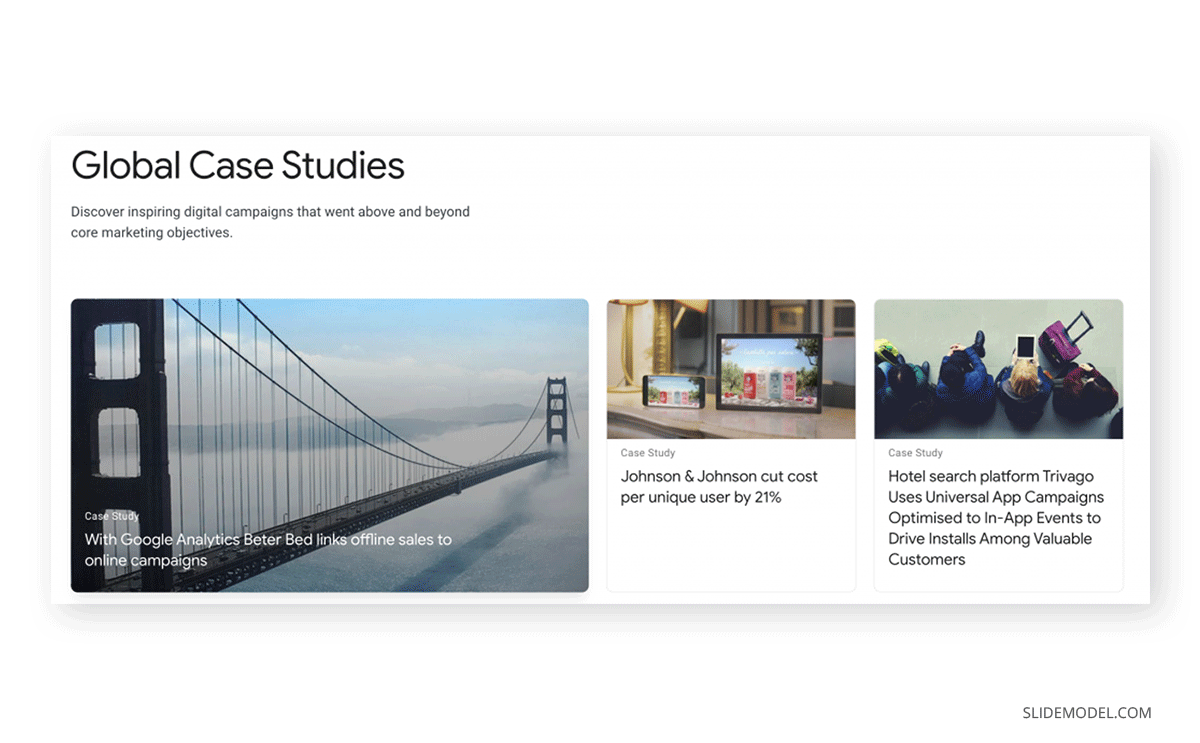
- Blog case studies — data-driven storytelling is a staunch way to stand apart from your competition by providing unique insights, no other brand can tell.
- Video case studies — video is a great medium for showcasing more complex business cases and celebrating customer success stories. This can combine your case analysis with real testimonials from customers which can make the video case study more engaging and effective.
How to Write a Case Study (a 4-Step Framework)
Once you decide on your case study format (be it a case study presentation, a blog case study, or a video), the next step is collecting data and then translating it into a storyline. There are different case study methods and research approaches you can use to procure data.
But let’s say you already have all your facts straight and need to organize them in a clean copy for your case study presentation deck. Here’s how you should do it.

1. Identify the Problem
Every compelling case study research starts with a problem statement definition. While in business settings, there’s no need to explain your methodology in-depth; you should still open your presentation with a quick problem recap slide.
Be sure to mention:
- What’s the purpose of the case study? What will the audience learn?
- Set the scene. Explain the situation that preceded the events, focusing on the challenges that the person was facing.
- Advertise the main issues and findings without highlighting specific details.
The above information should nicely fit in several paragraphs or 2-3 case study slides.
2. Explain the Solution
The bulk of your case study copy and presentation slides should focus on the provided solution. This is the time to speak about how the subject went from before to the glorious after.
Here are some writing prompts to help you articulate this better:
- State the subject’s main objective and goals. What outcomes were they after?
- Explain the main solution provided. What was done? Why this, but not that?
- Mention if they tried any alternatives. Why did those work? Why were you better?
This part may take the longest to write. Don’t rush it and reiterate several times. Sprinkle in some powerful words and catchphrases to make your copy more compelling.
3. Collect Testimonials
Persuasive case studies feature the voice of customer (VoC) data — first-party testimonials and assessments of how well the solution works. These provide extra social proof and credibility to all the claims you are making.
So plan and schedule interviews with your subjects to collect their input and testimonials. Also, design your case study interview questions in a way that lets you obtain quantifiable results.
4. Package The Information in a Case Study Slide Deck
Once you have a rough first draft, try different business case templates and designs to see how these help structure all the available information. At SlideModel, you can browse a collection of readymade case study presentation templates, ready for PowerPoint & Google Slides.
As a rule of thumb, keep one big idea per slide. If you are discussing a solution, first present the general bullet points. Then give each solution a separate slide where you’ll provide more context and perhaps share some quantifiable results.

For example, if you look at case study presentation examples from AWS like this one about Stripe, you’ll notice that the slide deck has few texts and focuses on the big picture, while the speaker provides extra context.
Need some extra case study presentation design help? Download our Business Case Study PowerPoint template with 100% editable slides. Otherwise, let’s continue to learn how to make a case study presentation.
How to Do a Case Study Presentation: 3 Proven Tips
Your spoken presentation (and public speaking skills) are equally if not more important than the case study copy and slide deck.
So, how to present a case study in a PowerPoint presentation?
To make a strong case study presentation, follow these quick techniques and effective presentation tips below. Alternatively, you can learn how to present a business case here.
Focus on Telling a Great Story
A case study is a story of overcoming a challenge and achieving something grand. Your delivery should reflect that. Step away from the standard Feature-Benefits sales formula or the FAB Technique in sales (which focuses on features, advantages, and benefits). Instead, make your customer the Hero of the case study. Describe the road they went through and how you’ve helped them succeed.
The premises of your story can be as simple as:
- Help with overcoming a hurdle
- Gaining major impact
- Reaching a new milestone
- Solving a persisting issue no one else code
Based on the above, use narrative techniques and storytelling to create a clear story arc. Show where your hero started. Then explain what type of journey they went through. Inject some emotions into the mix to make your narrative more relatable and memorable.
Experiment with Copywriting Formulas
Copywriting is the art and science of organizing words into compelling and persuasive combinations that help readers retain the right ideas.
To ensure that the audience retains the right takeaways from your case study presentation, you can try using some of the classic copywriting formulas to structure your delivery. These include:
- AIDCA — short for Attention, Interest, Desire, Conviction, and Action. First, grab the audience’s attention by addressing the major problem. Next, pique their interest with some teaser facts. Spark their desire by showing that you know the right way out. Then, show a conviction that you know how to solve the issue—finally, prompt follow-up action such as contacting you to learn more.
- PADS — is short for Problem, Agitation, Discredit, or Solution. This is more of a sales approach to case study narration. Again, you start with a problem, agitate about its importance, discredit why other solutions won’t cut it, and then present your option.
- 4Ps — short for Problem, Promise, Proof, Proposal. This is a middle-ground option that prioritizes storytelling over hard pitches. Set the scene first with a problem. Then make a promise of how you can solve it. Show proof in the form of numbers, testimonials, and different scenarios. Round it up with a proposal for getting the same outcomes.
Take an Emotion-Inducing Perspective
The key to building a strong rapport with an audience, which can help you in preparing the case study presentation, is showing that you are one of them and fully understand what they are going through.
One of the ways to build this connection is by speaking from an emotion-inducing perspective. This is best illustrated with an example:
- A business owner went to the bank
- A business owner came into a bank branch
In the second case, the wording prompts listeners to paint a mental picture from the perspective of the bank employees — a role you’d like them to relate to.
By placing your audience in the right visual perspective, you can make them more receptive to your pitches. The following image shows a simple minimalist slide for a Case Study presentation. In this slide, we can see icons associated with each of the components of the case study: a heart to define the problem, a brush icon in the Solution and a hand with a heart to show the Results of the case study.
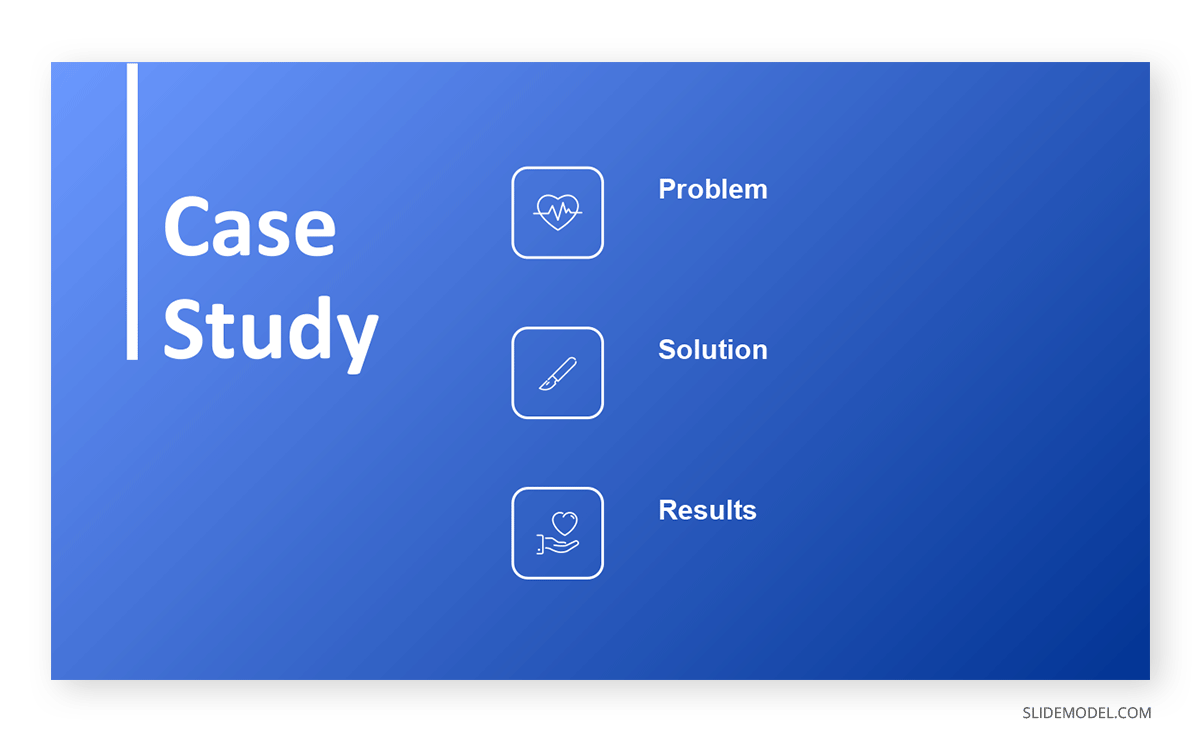
Graphics and icons can be used in other slides of your case study presentation.
For example, in our animated business case study presentation template, we included a Client Overview slide, which acts as a Company Profile slide, helping to describe the client, the service offerings, the company size, the location and the industry in which the client delivers it services.
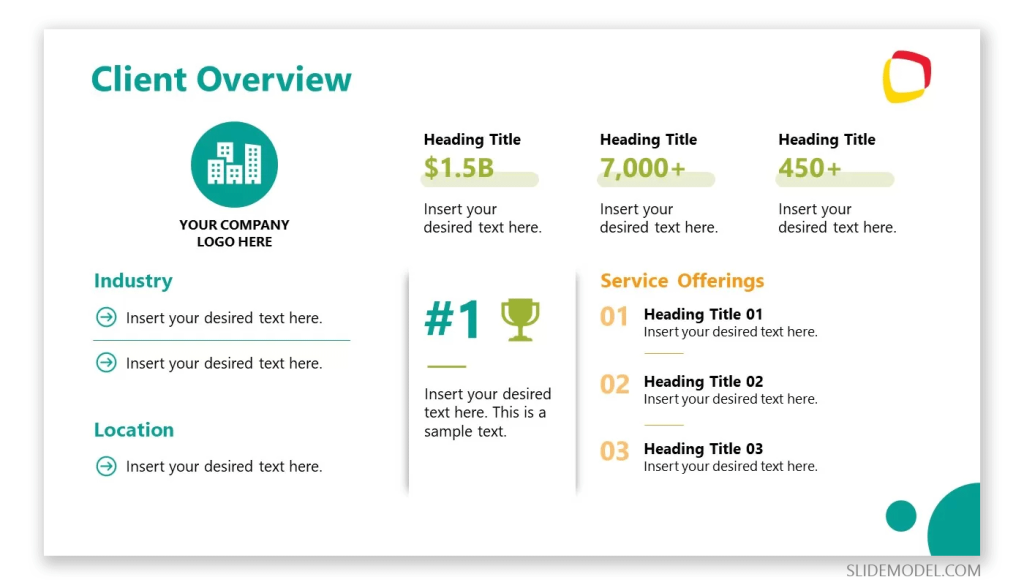
Case Study Presentation Structure: One-Slide vs. Multi-Slide
When presenting a case study, choosing the right structure depends on the depth of information and the time available. Below are two effective formats that you could take as case study presentation examples: a one-slide minimalistic presentation and a multi-slide detailed presentation.
1. One-Slide Presentation
A one-slide presentation condenses the entire case study presentation into key points, making it ideal for quick overviews or executive summaries. This case study format is also useful when you need to present case studies inside a bigger presentation.
How can you design the case study slide?
- At the top of the slide, you can include the presentation title and a brief one-sentence description of the problem to introduce the topic.
- On the left column, provide the Problem Statement—a concise explanation of the challenge, supported by one key metric.
- In the middle column, summarize the Solution—the steps or strategies implemented to solve the problem.
- On the right column, highlight Key Metrics with a visual representation such as a bar chart or infographic.
- At the bottom, conclude with Outcomes and Results, a bullet-point summary of achievements or impacts, ending with a bold call-to-action.
This format of case study PPT is best for quick pitches, high-level meetings with limited time, or audiences that only require essential takeaways. You can use a dashboard-style design and separate each section by components. Check out our dashboard presentation templates to review some dashboard examples.
2. Multi-Slide Presentation
A multi-slide presentation provides the space to elaborate on each aspect of the case study, making it a full case study slide deck, which could be suitable for in-depth discussions or workshops.
Possible structure of a multi-slide case study presentation deck:
- Title Slide: Include a cover of the case study, introduce the company.
- Introduction Slide: Purpose of the case study and a brief overview of the subject and context.
- Problem Statement Slide: A detailed explanation of the challenge or issue, supported by visuals or data.
- Solution Slides (2-3 slides): Breakdown of the solution into steps or phases. You can use visuals such as process charts or images to support each phase.
- Results Slide (2 slides): Quantitative data (e.g., graphs, charts, before and after comparisons). Consider including qualitative outcomes, such as testimonials or feedback from stakeholders.
- Key Insights Slide: In the key insights slide, include lessons learned, challenges faced, and recommendations for future cases.
- Recommendations and Next Steps Slide: Actionable key takeaways and suggestions for stakeholders.
- Closing Slide: Summary of key points and a final call-to-action (e.g., contact information or proposal for further collaboration).
This case study presentation format is ideal for client presentations, workshops, or detailed stakeholder reviews where a comprehensive analysis is needed.
Choosing the Right Format
The one-slide format is perfect for time-sensitive scenarios, executive overviews or when you need to present a case study slide inside a bigger presentation.
The multi-slide format works best for detailed discussions, storytelling, and engaging audiences with complex solutions and results.
How Long Should a Case Study Be?
One common question that arises when creating a case study is determining its length. The length of a case study can vary depending on the complexity of the problem and the level of detail you want to provide. Here are some general guidelines to help you decide how long your case study should be:
- Concise and Informative: A good case study should be concise and to the point. Avoid unnecessary fluff and filler content. Focus on providing valuable information and insights.
- Tailor to Your Audience: Consider your target audience when deciding the length. If you’re presenting to a technical audience, you might include more in-depth technical details. For a non-technical audience, keep it more high-level and accessible.
- Cover Key Points: Ensure that your case study covers the key points effectively. These include the problem statement, the solution, and the outcomes. Provide enough information for the reader to understand the context and the significance of your case.
- Visuals: Visual elements such as charts, graphs, images, and diagrams can help convey information more effectively. Use visuals to supplement your written content and make complex information easier to understand.
- Engagement: Keep your audience engaged. A case study that is too long may lose the reader’s interest. Make sure the content is engaging and holds the reader’s attention throughout.
- Consider the Format: Depending on the format you choose (e.g., written document, presentation, video), the ideal length may vary. For written case studies, aim for a length that can be easily read in one sitting.
In general, a written case study for business purposes often falls in the range of 1,000 to 2,000 words. However, this is not a strict rule, and the length can be shorter or longer based on the factors mentioned above.
Final Tip: Use Compelling Case Study Presentation Visuals
Our brain is wired to process images much faster than text. So when you are presenting a case study to an audience, always look for an opportunity to tie in some illustrations such as:
- A product demo or preview
- Processes chart
- Call-out quotes or numbers
- Custom illustrations or infographics
- Customer or team headshots
Use icons to minimize the volume of text. Also, opt for readable fonts that can look good in a smaller size too.
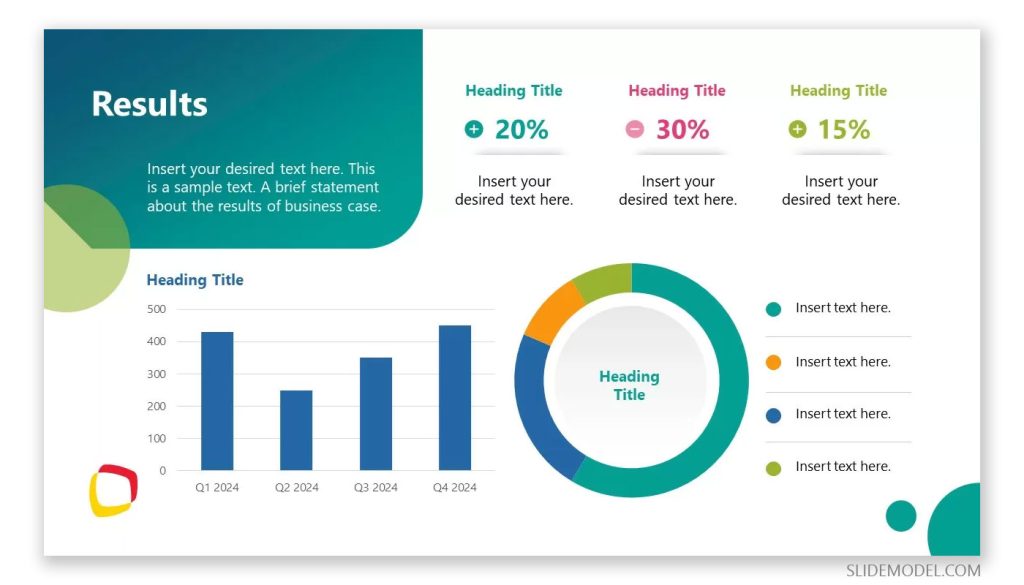
Business Case Study Examples
To better understand how to create an effective business case study, let’s explore some successful case studies examples:
Apple Inc.: Apple’s case study on the launch of the iPhone is a classic example. It covers the problem of a changing mobile phone market, the innovative solution (the iPhone), and the outstanding outcomes, such as market dominance and increased revenue.
Tesla, Inc.: Tesla’s case study on electric vehicles and sustainable transportation is another compelling example. It addresses the problem of environmental concerns and the need for sustainable transportation solutions. The case study highlights Tesla’s electric cars as the solution and showcases the positive impact on reducing carbon emissions.
Amazon.com: Amazon’s case study on customer-centricity is a great illustration of how the company transformed the e-commerce industry. It discusses the problem of customer dissatisfaction with traditional retail, Amazon’s customer-focused approach as the solution, and the remarkable outcomes in terms of customer loyalty and market growth.
Coca-Cola: Coca-Cola’s case study on brand evolution is a valuable example. It outlines the challenge of adapting to changing consumer preferences and demographics. The case study demonstrates how Coca-Cola continually reinvented its brand to stay relevant and succeed in the global market.
Airbnb: Airbnb’s case study on the sharing economy is an intriguing example. It addresses the problem of travelers seeking unique and affordable accommodations. The case study presents Airbnb’s platform as the solution and highlights its impact on the hospitality industry and the sharing economy.
These examples showcase the diversity of case studies in the business world and how they effectively communicate problems, solutions, and outcomes. When creating your own business case study, use these examples as inspiration and tailor your approach to your specific industry and target audience.
Finally, practice your case study presentation several times — solo and together with your team — to collect feedback and make last-minute refinements!
Featured Case Study Presentation Templates
FAQs
Can I use a case study presentation for marketing purposes?
Yes. Case studies are an effective marketing tool to showcase success stories, build credibility, and demonstrate how your solutions solve real-world problems. Use them in sales pitches, workshops, or website content to attract prospects.
What are the common mistakes to avoid in a case study presentation?
Avoid overloading slides with text or data, using poor-quality visuals, and failing to tailor the presentation to your audience. Ensure a logical structure, highlight key results, and practice your delivery to avoid common pitfalls.
What tools can I use to create a case study presentation?
To make a case study presentation, you can use presentation tools like PowerPoint and Google Slides. SlideModel can also be used to download readymade case study presentation templates that are 100% editable.
How do I handle Q&A sessions after a case study presentation?
Prepare for possible questions by reviewing your content thoroughly. Use the Q&A session to clarify key points, engage with your audience, and demonstrate expertise.
How do I choose between a one-slide case study presentation and a complete multi-slide presentation format for the case study?
Choose a one-pager case study format for quick summaries, executive meetings, or if you want to present the case study as part of a bigger presentation. Opt for a multi-slide format when presenting to a detailed audience, such as stakeholders or clients, where you need to provide in-depth analysis.
Can case study presentations be interactive?
Yes, adding interactive elements like clickable slides, animations, or live polls can make your presentation more engaging. Tools like PowerPoint and Google Slides allow for interactivity to cater to virtual or in-person audiences.

